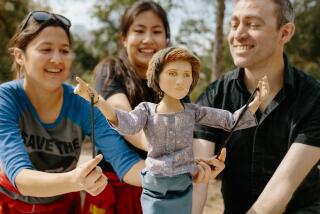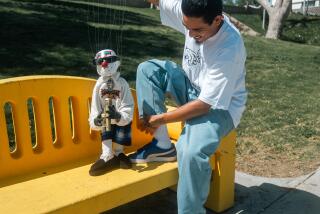Royal Showing of Puppetry in ‘Three Kingdoms’
- Share via
Once upon a time there were three kingdoms and a war waged to unite them. Centuries later, Kageboushi, a Japanese puppetry company, would collaborate with puppeteers from the Chengdu Puppet Arts Theatre Company of China as the Grand Puppet Theatre to stage “San Guo Zhi” or “Tale of Three Kingdoms.”
Performing in Los Angeles over the weekend at the Japan America Theatre in Little Tokyo as part of a world tour, this Sino-Japanese endeavor displayed the virtuosity that is possible when blending traditions. The puppets, constructed by Kihachiro Kawamoto, are a unique combination of the two traditions. Each human character is manipulated by one puppeteer, dressed in black and partially hidden by the front panels of the puppet’s elaborately detailed costume.
These puppets don’t strike the exaggerated poses often associated with bunraku. The women glide gracefully; the men stride boldly.
Using projected images and subtitles, the Grand Puppet Theatre tries to fill in the cultural and historical gaps.
Liu Bei is a sensitive guy who swears an allegiance of brotherhood with two boisterous warriors, the bearded Guan Yu and mutton-chop mustached Zhang Fei. In Act I, “The Three Visits of Supplication,” they are aided by military strategist Kongming in battles against northern general Cao Cao.
In Act II, “The Battle of the Red Cliff,” Kongming slyly convinces Sun Quan’s general, Zhou Yu, to join forces against Cao Cao.
James Miki’s script includes a battle on horseback, beheadings, a suicide and flaming ships--all handled expertly by this cast of puppeteers.
Yet the Grand Puppet Theatre doesn’t always bridge the gap between East and West. The English script translation by Katsumi Kunitsugu and Kaori Sawada is at times clunky and inadvertently hilarious. The subtitles are sprinkled with typos.
The two acts cover two years, and the narration notes that the war continued several years after. The grand sweep of culture and war overwhelms the character development, and neither Miki’s script nor Mimi Komori’s direction can compensate for the layering of cultural foundations that American audiences generally lack.
Still when the puppeteers take their bows and walk into the audience with these amazing creations, you know you’ve seen something special.
More to Read
The biggest entertainment stories
Get our big stories about Hollywood, film, television, music, arts, culture and more right in your inbox as soon as they publish.
You may occasionally receive promotional content from the Los Angeles Times.










